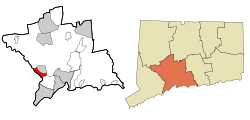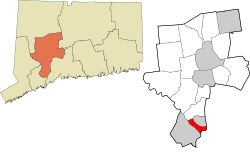Derby, Connecticut | |
|---|---|
| City of Derby | |
 Annual fireworks display from the Derby-Shelton Bridge in 2007 | |
| Motto: "Connecticut's Smallest City"[1] | |
| Coordinates: 41°19′36″N 73°04′56″W / 41.32667°N 73.08222°W | |
| Country | |
| State | |
| County | New Haven |
| Region | Naugatuck Valley |
| Settled | 1642 |
| Named | 1675 |
| Incorporated-town | 1775 |
| Incorporated-city | 1893 |
| Founded by | John Wakeman |
| Named for | Derby, England |
| Government | |
| • Type | Mayor-Board of Aldermen |
| • Mayor | Joseph DiMartino (D) |
| • Chief administrator | Andrew Baklik |
| Area | |
| • City | 5.41 sq mi (14.00 km2) |
| • Land | 5.06 sq mi (13.09 km2) |
| • Water | 0.35 sq mi (0.91 km2) |
| Highest elevation | 469 ft (142 m) |
| Lowest elevation | 3 ft (1 m) |
| Population (2020) | |
| • City | 12,325 |
| • Rank | 19th (CT) |
| • Density | 2,435.8/sq mi (941.6/km2) |
| • Metro | 861,113 (US: 60th) |
| • CSA | 23,076,664 (US: 1st) |
| Time zone | UTC-5 (Eastern) |
| • Summer (DST) | UTC-4 (Eastern) |
| ZIP code | 06418 |
| Area code(s) | 203/475 |
| FIPS code | 09-19480 |
| GNIS feature ID | 0206671 |
| Major highways | |
| Commuter rail | |
| Website | www |
Derby /ˈdɜːrbi/ is a city in New Haven County, Connecticut, United States, approximately 8 miles (13 km) west-northwest of New Haven. It is located in southwest Connecticut at the confluence of the Housatonic and Naugatuck rivers. It shares borders with the cities of Ansonia to the north and Shelton to the southwest, and the towns of Orange to the south, Seymour to the northwest, and Woodbridge to the east. The city is part of the Naugatuck Valley Planning Region. The population was 12,325 at the 2020 census.[3] It is the smallest city in Connecticut by area, at 5.3 square miles (14 km2).[4]
Derby was settled in 1642 as an Indian trading post under the name Paugasset. It was named after Derby, England, in 1675.[5][6] It included what are now Ansonia, Seymour, Oxford, and parts of Beacon Falls.
Derby is home to the first electric trolley system in New England, only the second in the United States. It is also home to the first electric locomotive in U.S. history to be built and successfully used commercially for hauling freight. The locomotive, built in 1888, is still kept in running condition by the Shore Line Trolley Museum.[7][8]
- ^ "City of Derby Connecticut". City of Derby Connecticut. Retrieved September 22, 2012.
- ^ "2019 U.S. Gazetteer Files". United States Census Bureau. Retrieved July 2, 2020.
- ^ "Census - Geography Profile: Derby city, Connecticut". Retrieved November 28, 2021.
- ^ "History of Derby, city website". Retrieved February 15, 2019.
- ^ Gannett, Henry (1905). The Origin of Certain Place Names in the United States. Govt. Print. Off. pp. 104.
- ^ The Connecticut Magazine: An Illustrated Monthly. Connecticut Magazine Company. 1903. p. 331.
- ^ "First Trolly Run 1888". Retrieved September 22, 2018.
- ^ "Derby Historical Quiz". Retrieved September 22, 2018.






